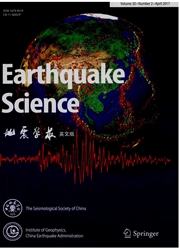

 中文摘要:
中文摘要:
1999年台湾集集地震震后450天的GPS观测资料显示了几十到几百毫米的地表位移.下地壳的震后黏性松弛和断层无震蠕变产生的震后滑动是用来解释地表震后变形的两个主要机制.本文利用接触问题的黏弹性有限元(LDDA)方法,以GPS观测数据作为约束,分别考察了黏性松弛和震后滑动机制对地表震后变形的影响.计算结果表明,黏性松弛机制产生的地表位移与观测数据吻合较好,通过试错法由震后GPS观测约束得到的下地壳黏度为1017Pa.s,而上地幔黏度对计算结果影响不大.考察震后滑动机制对地表变形的影响时,在LDDA方法中结合了速率状态摩擦定律,结果显示震后滑动机制不能很好地解释震后450天的观测数据,它产生的地表变形只在震后50天内与观测大致吻合,之后位移值基本不随时间变化.这些结果有助于增进对集集地震震后变形机制的认识.
 英文摘要:
英文摘要:
GPS measurements of 450 days after the 1999 Chi-Chi, Taiwan, earthquake revealed large postseismic displacement from dozens to hundreds of millimeters. Two possible mechanisms responsible for the postseismic deformation of the surface are the viscous relaxation of the lower crust and the afterslip caused by the aseismic creep of the earthquake fault. In this study, the finite element method (LDDA) for the viscoelastic contact problems is used to simulate the postseismic deformation process of the 1999 Chi-Chi earthquake with the GPS data as constraints. And the two possible mechanisms, viscous relaxation and afterslip, are discussed. The results indicate that the postseismic deformation observed by GPS can be well explained by the viscous relaxation mechanism. The viscosity of the lower crust below the Taiwan area is estimated as 1017 Pa ~ s by the trial and error method. The effect of afterslip mechanism on the postseismic deformation of the Chi-Chi dependent frictional law. earthquake is investigated by the numerical method with rate-and-state The results suggest that the GPS data cannot be explained by theafterslip mechanism alone, which only affects the postseismic deformation in the early 50 days after the mainshock. These studies will throw light on understanding the mechanism of the postseismic deformation of the 1999 Chi-Chi, Taiwan, earthquake.
 同期刊论文项目
同期刊论文项目
 同项目期刊论文
同项目期刊论文
 Effects of large historical earthquakes, viscous relaxation,and tectonic loading on the 2008 Wenchua
Effects of large historical earthquakes, viscous relaxation,and tectonic loading on the 2008 Wenchua 期刊信息
期刊信息
